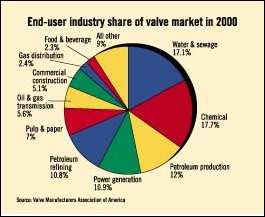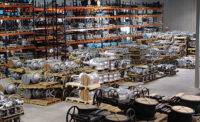
Is the glass half empty or half full? Most distributors of industrial pipe, valves and fittings seem to be taking the more optimistic view. Given the fact that the glass was virtually empty in 1999, anything poured into it this year will make a noticeable difference. However, few expect the PVF cup to runneth over any time soon.
Some PVF wholesalers were already seeing improvement in the last quarter of '99. Joe Clover, general manager of Sunbelt Stainless Products (Atlanta) has seen some positive changes in the last few months.
"The pulp-and-paper market started getting better as paper prices came up in the last quarter of 1999," he said. "However, I don't know that we'll ever see the paper industry in the United States be what it once was. A lot of the companies have moved their mills to Mexico and South America."
Clover expects continued strength in the stainless-steel market, observing that as prices have improved, so has demand. He doubts the upturn will last more than a year or 18 months, though. He pointed to stunted growth in the corn-processing industry as one cause. "That industry uses very large amounts of stainless piping products," he said.
The view is good on the West Coast, said Bob Cooper, vice president/ sales and marketing for Smith-Cooper (Montebello, Calif.). "The economy is going to be strong," he said. "There are a lot of projects on the books, and that's promising. I'm very optimistic about 2000."
Again, however, this optimism is tempered by a hunch that the peaks in business will be lower in the future. As a result, Smith-Cooper has decided to diversify its product offering while narrowing its customer focus somewhat. The firm is acquiring a valve company, which will add a product category and some new locations.
At the same time, though, Cooper reported that the firm was shifting its emphasis even more to the industrial market. "Prices are going up, and the supply isn't there," he said. "It's not a bad place to be if you have inventory, and we have the metal on the shelves."
Both Cooper and Clover expect imported product to gain wider acceptance among end users.
"I've seen some high-quality cast products from China," Clover said. "A lot of manufacturers in China are actually Taiwanese companies that moved their operations to the mainland because of labor costs or dumping problems."
In the Midwest, a slowdown in agriculture-related business means problems for distributors selling to companies ranging from farm-equipment manufacturers to processing plants, said Steve Anderson, president of Central States Industrial Supply (Omaha, Neb.). He's not betting the farm that things will improve any time soon.
"Theoretically the overseas market is getting better," Anderson said. "Our customers will be exporting more, and we hope that means they'll be adding to their plants. But we don't know for sure that it's going to happen, and if it does, it'll be later in the year. So we're not depending on it."
The macro view
In 1999, one of the few bright spots for industrial PVF distributors was the water and sewer market. According to Cahners Economics, construction of such projects jumped 11.1% last year. Cahners also predicts a good year among these customers in 2000, with a 5.1% increase over ?99. Other utility projects will do even better, with a projected 8.5% improvement following a 2.3% drop in 1999.Cahners also predicts something of a turnaround in industrial-construction expenditures, which were down nearly 10% last year. The 3.4% improvement this year won?t get the spending on such projects back to the $32.2 billion level of 1998 but will be welcome nonetheless.
"Through October 1999, total spending on industrial construction work was almost 20% lower than through October 1998," reported economist Daryl Delano in Cahners Building & Construction Market Forecast. "We'll see some recovery in industrial construction demand during 2000 as the global economy grows at a healthier rate."
The National Association of Purchasing Management anticipates overall manufacturing growth of 7.7% this year. More to the point, NAPM predicts that the biggest increase will be in industrial and commercial equipment and computers, followed by chemicals.
If manufacturers of industrial equipment are expecting to sell more product, it seems reasonable for distributors of industrial material to look for an upturn, too.

